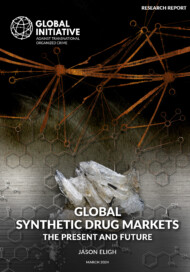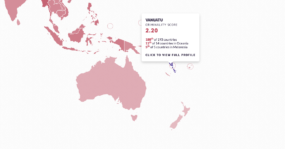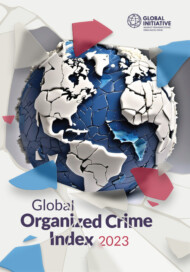Posted on 21 Jun 2024
Australia and New Zealand are among the world’s most lucrative consumer markets for drugs. A surge in demand over the last two decades, particularly for methamphetamines and cocaine in the 2010s, led to the drugs trade reaching record levels by 2020. Not even the disruptions associated with the COVID-19 pandemic were able to slow this trend.
Today, wastewater reports from Australia and New Zealand identify methamphetamines as the dominant drug of choice, with the market value increasing year on year. And, although consumption rates are not as high as they were before the pandemic, they have recovered from the supply chain disruptions associated with the pandemic and remain worryingly high.
Located midway between drug-producing countries in Asia and the Americas, and consumer markets in Australia and New Zealand with their persistent levels of consumption, the Pacific islands have become transit points – the Pacific ‘drug highway’, as the region has been referred to. However, Pacific island countries (PICs) and territories are no longer just transit points – countries such as Tonga and Fiji have developed domestic consumer and production markets. Findings from the 2023 Global Organized Crime Index show that synthetic drug markets in PICs are now second only to the cannabis trade, and in some cases have overtaken it.
Digging deeper into the Index’s data, half of the countries in Oceania experienced an increase in the severity of illicit synthetic drug markets between 2021 and 2023. These are New Zealand, Papua New Guinea, Fiji, Tonga, Samoa, Nauru and the Federated States of Micronesia.
As for the others, Australia remained home to a ‘significant’ synthetic drugs market and Palau had a ‘moderately influential’ one. Kiribati, the Marshall Islands, Vanuatu and Tuvalu exhibited ‘virtually non-existent’ markets. Solomon Islands also falls into the lowest category in terms of severity. Yet unprecedent seizures in late 2023 revealed the emergence of a local market for methamphetamine and ketamine, suggesting that these narcotics have now reached the Melanesian country as well.
The level of resilience to organized crime varies considerably across the continent. The main divide in terms of resilience measures is between Australia and New Zealand, which have sufficiently effective resilience mechanisms and tools on the one hand, and PICs on the other. On the islands, resilience levels are, at best, moderately effective, albeit with country-specific variations. This suggests that there is a risk that local policy frameworks, law enforcement, public health systems and civil society organizations are generally not well prepared to withstand the apparent surge in domestic synthetic markets, including local trade and consumption.
A new trade
The uptrend in synthetic markets shows no sign of abating. In Solomon Islands, an investigation launched in late 2023 revealed that logging camps were being used as conduits for the methamphetamine trade. Chinese entrepreneurs were believed to be importing the drugs to be sold in small quantities to local Chinese businesspeople, land owners, loggers and nightclubs in the capital, Honiara, suggesting the emergence of a domestic consumer market that had not existed before. These substances are so new in Solomon Islands that they are not even included in the list of ‘dangerous drugs’ banned in the country.
In January 2024, Fiji reported what was possibly its biggest ever drug bust, when authorities seized 3.5 tonnes of methamphetamines. Investigators believed the drugs were being shipped to Australia, allegedly with the help of officials and members of a pharmaceutical company.
Papua New Guinea has also become a significant hub in the methamphetamine supply chain. Earlier this year, a politically connected Chinese businesswoman who had built a large business empire in the country was charged with facilitating a black flight that landed in Australia with over 70kg of methamphetamine. The Brisbane-based woman, who denied all allegations, was granted bail awaiting trial.
This emerging pattern of meth in the region is shaped by foreign organized criminal actors who are increasingly infiltrating the Pacific Islands. Evidence suggests that it is largely the trade in synthetic drugs, cocaine and heroin that is attracting organized criminals to the Pacific. Despite the involvement of some Pacific islanders, those that control the supply chain are Asian syndicates, Central and South American cartels, outlaw motorcycle gangs and minor, opportunistic criminals from Europe and the Middle East.
Chinese organized crime groups and Mexican cartels are key to the synthetic drug trade. From the 1990s, methamphetamines produced in southern China were commonly trafficked to Australia. Then a 2015 counternarcotics agreement between Canberra and Beijing was able to put a dent in this trade. However, Chinese precursors (chemicals used in the manufacture of drugs) trafficked from Myanmar have since been used to produce methamphetamines, which are exported by triads to Australia and New Zealand.
China is also the main supplier of precursors to the Mexican cartels. Latin American cartels, particularly from Mexico, dominate the cocaine supply chain to Australia and New Zealand. However, the same cartels have also developed relationships with Asian syndicates and chemical companies based in China that sell the precursors used to manufacture fentanyl. Criminal networks appear to be effectively and efficiently connecting global supply and demand.
The emerging trends observed in Oceania point to the urgency of tackling the trade in synthetic drugs. This requires law enforcement and public health efforts. It also means gaining a better understanding of these markets in PIC, where information and data are patchy (in contrast to Australia and New Zealand).
This knowledge gap is to some extent related to the lack of capacity of local authorities to collect data, which is only partially addressed through reliance on regional organizations. In addition, unlike neighbouring South East Asia, for example, most PICs have not had established local markets for synthetic drugs (and therefore have not been a priority for data collection), and local authorities are still adjusting to new trends. Developing a better understanding of the dynamics of new emerging markets – which are catching some Pacific authorities by surprise – with the help of longitudinal analytical tools like the Global Organized Crime Index seems critical to more effectively combat these crimes.
This analysis is part of the GI-TOC’s series of articles delving into the results of the Global Organized Crime Index. The series explores the Index’s findings and their effects on policymaking, anti-organized crime measures and analyses from a thematic or regional perspective.



